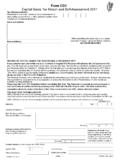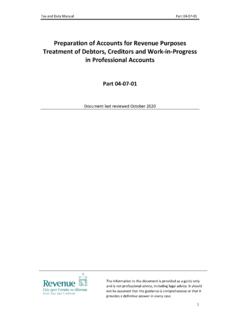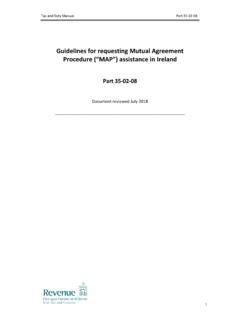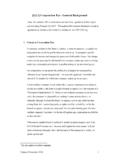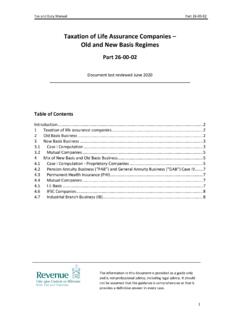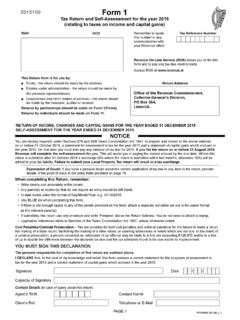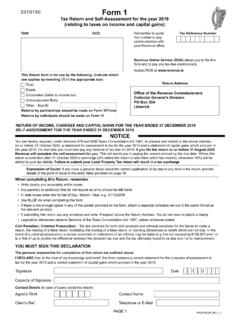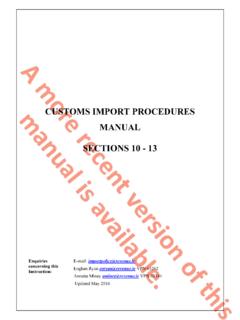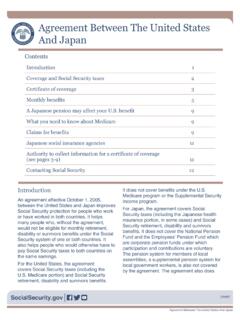Transcription of Part 7: Exemptions and Reliefs from Stamp duty - Revenue
1 Tax and Duty ManualSDCA - Part 7 Exemptions and Reliefs1 Stamp Duties Consolidation Act 1999 Part 7: Exemptions and Reliefs from Stamp dutyThis document should be read in conjunction with part 7 of the Stamp Duties Consolidation Act (SDCA) 1999 Exemptions and Reliefs from Stamp DutyDocument last updated January 2019_____The information in this document is provided as a guide only and is not professional advice, including legal advice. It should not be assumed that the guidance is comprehensive or that it provides a definitive answer in every case. white line wrote to hide the page number in the footer. white line wrote to hide the page number in the footer. white line wrote to hide the page number in the footer. Tax and Duty ManualSDCA - Part 7 Exemptions and Reliefs2 Table of 79 - Conveyances and transfers of property between certain bodies of Duty of the for claiming 80 - Reconstructions or amalgamations of of acquiring/target reconstructions or of terms used in section 80A - Demutualisation of assurance 81AA - Young Trained 81C - Farm 81D - Relief for Certain Leases of 82 - 82A - Donations to approved 82B - Approved Sports 82C - Pension schemes and 83A - Transfer of site to 83B - Certain Family Farm 83C - Property trade in 83D - Refund scheme where land used for residential 85 - Certain Loan Capital and 85A - Certain Investment 86A - Enterprise Securities Market_____14 Tax and Duty ManualSDCA - Part 7 Exemptions and 87B - Merger of of foreign 88 - Certain stocks and marketable 90 - Certain financial services 90A - Greenhouse gas 91A - New houses or
2 Apartments with a floor area compliance 92 - New dwelling houses and apartments with no floor area compliance 92B - First time buyer 95 - Commercial Woodlands 96 - Transfers between spouses and civil 97 - Certain transfers following the dissolution of marriage or civil 97A - Certain transfers by 101 - Intellectual 101A - Single Farm 106B - Housing Authorities/Affordable Homes 108 - National Treasury Management 111 - Oireachtas 113 - Miscellaneous Instruments_____20 Tax and Duty ManualSDCA - Part 7 Exemptions and Reliefs4 Chapter 1: Instruments in respect of which a self-assessed Stamp Duty Return must be filed under the eStamping system in order to obtain exemption or 79 - Conveyances and transfers of property between certain bodies corporateThis section provides for a relief from Stamp duty on certain transfers of property in a corporate group. corporateThe term body corporate is not defined in legislation, however it includes: Limited and Unlimited companies, Foreign companies, Industrial and provident societies, Building societies, Incorporated associations.
3 Foreign bodies corporate which do not have a capital structure based on share capital may also claim the relief by reference to section 79(9), provided they have a capital structure which is equivalent to a share capital structure and also comply with all other conditions of the of chargeThe relief is confined to instruments chargeable under or by reference to the heads of charge: Conveyance or Transfer on sale of any stocks or marketable securities Conveyance or Transfer on sale of a policy of insurance or a policy of life insurance where the risk to which the policy relates is located in the State Conveyance or Transfer on sale of any property other than stocks or marketable securities or a policy of insurance or a policy of life insurance. As Lease is a separate head of charge, leases do not come within the scope of the Duty ReturnAdjudication has been abolished for instruments executed on or after 7 July 2012 and a self-assessed Stamp Duty Return is required to be filed under the eStamping system to claim this and Duty ManualSDCA - Part 7 Exemptions and ownershipRelief is available in relation to an instrument under which a beneficial interest in property is conveyed or transferred between associated bodies company will cease to be the beneficial owner of property if it is in liquidation or has entered into an un-conditional contract to sell the statusTo qualify for intra-group relief under section 79 SDCA both the primary test in Section 79(3) and the secondary test in Section 79(4) must be testThe primary test (prior to 6 February 2003) was based on 90% of issued share capital.
4 Under the Finance Act 2003 (section 136) the basis for the primary test was amended to ordinary share capital, which means the issued share capital excluding capital the holders of which have a right to a dividend at a fixed rate, but have no other right to share in the profits of the body corporate . testThe secondary test is provided for in Section 79(4) and must be satisfied in addition to the primary test in Section 79(3). The amendment introduced in the Finance Act 2003, and referred to in paragraph above, did not impact on Section 79(4). The secondary test focuses on the entitlement to 90% of (a) profits available for distribution and (b) assets available for distribution on a winding-up. Section 79(8) provides that, for the purposes of Section 79(4), the required percentage to be held within the group is to be calculated in line with Sections 414 and 415 of the Taxes Consolidation Act 1997 (TCA).The percentage test in Sections 414 and 415 of the TCA is calculated on the basis of the entitlement of equity holders in the company and an equity holder takes its meaning from Section 413 of the TCA.
5 An equity holder is a holder of shares other than fixed-rate preference shares as defined in Section 413 of the provisionsThe relief will not apply unless it can be shown that the instrument was not executed in pursuance of or in connection with an arrangement where: the consideration (or any part of it) for the transfer was to be provided or received directly or indirectly by an unassociated third party, or the beneficial interest was previously conveyed or transferred, directly or indirectly, by an unassociated third party, or the transferor and transferee were to cease to be associated. The relief will not be denied where the consideration (or any part of it) is borrowed from a financial institution as part of an independent commercial transaction. Tax and Duty ManualSDCA - Part 7 Exemptions and relief under section 79 of the SDCA is not allowed on a transfer of Irish shares to a connected company by a recognised intermediary whose own purchase of the shares concerned was exempt from Stamp duty by virtue of the relief for intermediaries in section 75 of the SDCA.
6 Of the reliefA clawback of section 79 relief arises where: it is found that the relief was not properly due, or the qualifying relationship between the transferor and the transferee ceases to exist within the period of two years from the date of the clawback provision in section 79(7)((b) of the SDCA, linked to the requirement to maintain the group relationship for a period of two years, is designed to enhance the other anti-avoidance provisions in section 79. There may be circumstances where the group relationship is broken without undermining the underlying rationale of the relief. ExampleSubsidiary company A transfers all its assets to its parent company B and obtains relief under section 79. Company A is now dormant and it is to be liquidated. The liquidation and strike off of company A results in the cesser of the group relationship between company A and company B. A clawback will not be pursued in such circumstances where: the transferred assets are retained within the company group for the period of two years from the date of the original transfer, the liquidation is effected for bona fide commercial reasons and the transaction is not part of a scheme or arrangement for the avoidance of any tax or availability of the above treatment will be decided on a case-by-case basis having regard to the facts and circumstances of each individual case.)
7 For claiming reliefIn order to obtain the relief a self-assessed Stamp Duty Return is required to be filed under the eStamping system in respect of the and Duty ManualSDCA - Part 7 Exemptions and 80 - Reconstructions or amalgamations of companiesFor various commercial reasons, a company may rearrange its business activities by merging with another company; acquiring another company, or reorganising its corporate transactions generally involve transfers of either shares or property. When shares are issued as consideration for the shares or property transferred the transaction may be classed as a reconstruction or amalgamation . is no statutory definition of a reconstruction , however it has been held that a scheme for the reconstruction of a company comprises the transfer of the undertaking, or part of the undertaking of an existing company to a new company with substantially the same members, and must involve the carrying on by the new company of substantially the same business as that transferred (Brooklands Selangor Holdings Ltd v IRC [1970] 2 All ER 76 and Baytrust Holdings Ltd v IRC [1971] 3 All ER 76) Reconstructions and amalgamations can be effected in two ways.
8 Share for share exchange in which the acquiring (transferee) company issues shares to the shareholders of the target (particular existing) company in exchange for their shares in the target company, or share for undertaking exchange where the acquiring company issues shares to either the target company or to shareholders in the target company in exchange for the undertaking or part of the undertaking of the target of the relief is subject to meeting certain conditions, including: There must be a bona fide scheme of reconstruction or amalgamation. The scheme must be effected for bona fide commercial purposes. The purpose of the reconstruction/amalgamation must not be tax avoidance. The acquiring company must be limited. It is to be incorporated or a pre-existing company has its nominal share capital increased, with a view to the acquisition of:o90% of the issued share capital of the target company; or othe undertaking or part of the undertaking of the target company.
9 Tax and Duty ManualSDCA - Part 7 Exemptions and Reliefs8 The issue of authorised (nominal) but unissued share capital by the acquiring company will be regarded as an increase in its nominal share capital. The consideration for the acquisition (other than any portion comprising the transfer to or discharge by the acquiring company of liabilities of the target company) must consist of not less than 90% in the issue of shares in the acquiring company to: the shareholders in the target company (where shares are being acquired), or the target company or holders of shares in the target company (where an undertaking is being acquired).An instrument in respect of which the relief is being claimed must have been executed within 12 months of the date of the registration of the acquiring company or the date of the resolution increasing the nominal share capital of the acquiring company, or have been made for the purposes of effecting a conveyance or transfer in pursuance of an agreement which has been filed, or particulars of which have been filed, with the Registrar of Companies within the 12-month period.
10 Adjudication has been abolished for instruments executed on or after 7 July 2012 and a self-assessed Stamp Duty Return is required to be filed under the eStamping system to claim this company will not be regarded as a target (particular existing) company unless it is provided in the memorandum of association of the acquiring company that, if it is registered or incorporated for the purposes of the acquisition, it has as one of the objects the acquisition of the undertaking of, or shares in, the target company. In the case of an increase in capital, the resolution must show that the increase is authorised for the purposes of acquiring the undertaking of, or shares in, the target company. The memorandum of association or the resolution of the acquiring company must identify the target company with reasonable term undertaking has a wide meaning. It involves a level of activity as opposed to the mere ownership of assets. The meaning of undertaking has been discussed in a number of cases, some of which are referred to in the table below.

